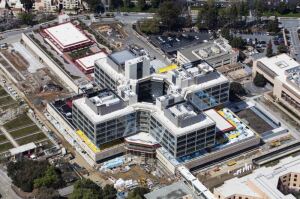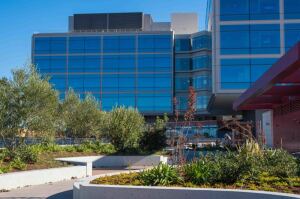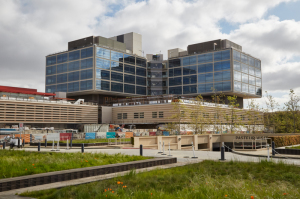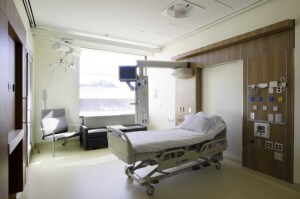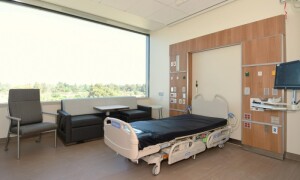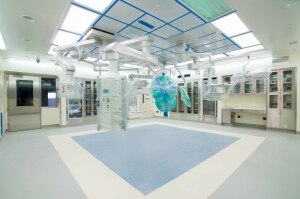Q&A with David Entwistle, president and CEO, Stanford Health Care
August 14, 2018
by Sean Ruck, Contributing Editor
HealthCare Business News spoke with Stanford Health Care president and CEO David Entwistle about his background, the efforts Stanford is taking to make use of their Silicon Valley connections, and some of the exciting advances they are seeing as a leading academic medical center.
HCB News: What inspired you to follow a career in healthcare?
David Entwistle: In high school, I took three years of Latin. I was determined to be an attorney. Then I had the opportunity early on in my collegiate journey to meet some individuals who were attorneys, and I determined pretty quickly that it wasn’t the right career path for me. After being introduced to several healthcare CEOs, I really got excited about the idea of dedicating my career to something that really benefitted individuals. These CEOs I met early on showed me that, through hard work, it is possible to improve the health of entire communities.
HCB News: What attracted you to Stanford Health Care?
DE: My career focus has always been on academic medicine. I really enjoy the teaching, research and clinical aspects of what we do. Academic medical centers are at the leading edge of patient care. We’re developing the latest technologies, the latest treatments, and we’re doing research that drives where the industry is going. When I got the call from a recruiter at Stanford Health Care, I said to myself that I could not miss the chance to work at what I think is one of the best academic medical centers in the country. The opportunity to work in the heart of Silicon Valley, where digital health technology is reaching a tipping point, was also too good to pass up. Healthcare is such a labor-driven industry, and it’s expensive. I believe that technology—used in the right ways—can be a powerful tool, so that’s why I want to not only improve the efficiency and quality of healthcare, but to create more consumer-friendly experiences for our patients.
HCB News: What attracts patients and employees to Stanford Health Care?
DE: There’s certainly a strong brand recognition. But more important, what we’re able to do with the incredibly talented and experienced professionals here is astounding. The people who come to work at Stanford Health Care continue to push the boundarides of what’s possible. From the CAR-T therapy we’re pioneering today to our recent 50-year celebration of the first heart transplant in America, which happened right here at Stanford, innovation is very much a part of our DNA. I think there’s also a very collaborative spirit at Stanford Health Care that enables us to bring a breadth of expertise together to tackle some of the most complex challenges in medicine today. From a patient perspective, there’s not only incredible patient safety, there is a long history of excellence. We are at the forefront of technology and have always been.
HCB News: What developments are happening at Stanford today?
DE: We’re building a new hospital—set to open in 2019—and we continue to develop our network in the Bay Area to improve patient access to our world-class services. There are a lot of exciting things we’re doing in digital as well. We’re going live with digital pathology, where we use digital slides instead of traditional ones. It allows us to collect huge datasets, so that they can be predictive tools and aid the pathologists in what they’re doing.
HCB News: What kind of relationships have you developed with Silicon Valley entities?
DE: As you may have seen in the news, one of the more exciting projects we’ve recently launched is with Apple on the Apple Heart Study. It uses an app designed to notify participants when they have an irregular heartbeat. This is something we’ve developed with our cardiologists and the tech folks at Apple.
With Google Research, we’re working on a project called Digital Scribe. A pilot program is evaluating whether machine learning technology and voice recognition software can be used to automate note entry for doctors in the electronic health record. The goal is to free up doctors so that they don’t have to be typing notes on a computer during patient visits.
We’re also partnering with a local company to put digital tracking into one of our ORs that will allow us to track time and motion data within the ICUs so that we can learn what will help patients get out of the hospital more quickly.
HCB News: What do you think Stanford and Stanford Health care are best-known for today?
DE: The linear accelerator was developed here. We’re partnering with Hitachi to deliver the first carbon-based radiation therapy. And we continue to push the bar. I think that just speaks to what we’re known for – having a culture of innovation that allows us to press the boundaries not only on novel therapies, but also the therapies that are already out there.
HCB News: Is there anything you’re working toward becoming better-known for going forward?
DE: Certainly one of the things, with our location in Silicon Valley, I’d like for us to be better-known for using the technology originating here. One of our strategic priority areas is a call for being digitally driven. I’d like for patients, unless they need something physically done for them, to have greater access to care remotely through technology, whether it’s through an Apple watch, apps, or a scale at home that’s connected to WiFi that can send in the data. The IT is incredible, the potential of the digital health technologies is enormous, and we’ve only scratched the surface.
HCB News: Can you discuss key challenges your organization faces?
DE: I think we’re always challenged on how we continue to push the bar on quality. Making sure we’re continuing to get better at what we do. The patient experience is paramount. You and I might judge that patient experience differently. For you, it might be a question of getting your appointment on time. For healthcare professionals, we look at mortality rates, infection rates, and all the things that are important to us, but we can always improve the patient experience. So that’s a challenge we always keep in mind so we can stay ahead of the curve.
The cost side of healthcare is also a real challenge. It is not as transparent as we would like. Therefore, it’s difficult to understand what the costs are. However, we continue to work on making it understandable for our patients.
HCB News: How fast has Stanford Health Care’s list of satellite sites grown, and how many sites do you anticipate will be added in the next few years?
DE: What I want to make sure of as we grow, is that the satellites are there to bring high quality medical care closer to home for our patients. For example, we just opened a facility in Emeryville to provide easier access. During certain times of the day, it’s a two-hour drive from Palo Alto, so providing services there for patients is a real win for them. Throughout our network, we’re growing the size of the footprint to meet the demand for our services. For the services we offer, we try to augment our flagship centers to reflect the needs of the community as opposed to having a “build it and they will come” mentality. Quite frankly, a significant portion of growth for us is in outpatient care, so our focus is on ensuring that our patients receive the right care, at the right time, and in the right setting.
HCB News: How do you keep all your providers on the same page in regard to following patient progress across different locations?
DE: We spend a lot of time and energy making sure we communicate in multiple voices and through various channels. In fact, this week, I’m holding two employee forums, which I do on a fairly consistent basis and other members of our executive team do as well. It’s an effort to find out the best ways to keep the organization connected. It’s easier on our main campus to do that, but it’s important to do that at the satellite locations as well. In addition, we recently launched the same patient record system at two of our satellite locations, so that – no matter where our patients receive their care – the experience and access to data are the same.
HCB News: Do you ever use satellite sites as test runs for new technologies or approaches?
DE: We do. For example, there’s a facility in Santa Clara where we’ve tested a lot of our new technology. In fact, a technology I mentioned above, the voice recognition equipment, is being tested there. It does make it a bit more flexible testing technology in a smaller setting.
HCB News: What are your predictions on how healthcare should change and how it might change over the next five to 10 years?
DE: I hear a lot of people talking about artificial intelligence. It’s one of those differentiators in our field. We’re collecting exobytes of information in such a way that it allows us to garner trends, patterns, etc. So digital pathology is something that is exciting in that way. Pre-reads done by computers that look through this information would be an application of that piece.
Another example would be clinical genomics. By using whole-exome sequencing to search for genetic disorders, we’re able to diagnose up to 25 percent of the patients who had previously gone undiagnosed for genetic diseases.
Another ongoing change will be the shift from inpatient to outpatient. Even though we’re building this world-class facility, outpatient will continue to be a driver for our organization. I think we’ll also see consolidation continue and systems coming together.
In the future, I hope that healthcare becomes more transparent for our patients and all other stakeholders. I know we’ll continue to build on the quality of data and experience of care. The industry has been slow to do this, but we’re getting better.
Hospital Spotlight: Stanford Health Care
Stanford Health Care
Location: Stanford, California
Year founded: 1959
Number of beds: 613 licensed beds
Number of employees: 12,166
President and CEO: David Entwistle
Noteworthy distinctions:
Ranked in the top 10 of the best hospitals in the nation by U.S. News & World Report. Only Level 1 trauma center between San Francisco and San Jose. Almost 54,000 emergency room visits in 2017 and 25,160 inpatient visits. The health system had 1.2 million outpatient visits in 2017 alone. The Stanford Stroke Center is designated as a comprehensive stroke center and Stanford’s Cancer Institute is an NCI Designated Comprehensive Cancer Center. Stanford Health Care has been a designated Magnet Hospital for three consecutive years by the American Nurses Credentialing Center.
Specialties:
1. Cancer
2. Cardiovascular
3. Neuroscience
4. Orthopedics
5. Solid organ transplantation
Recent developments:
The new Stanford Hospital is slated to open in 2019 and will deliver a model of coordinated care that's built around the unique physical and emotional needs of each patient. Designed by the internationally recognized firm Rafael Viñoly Architects, the new 824,000 square-foot facility will feature amenities and services focused on the health and well-being of patients, as well as the most advanced diagnostic, therapeutic and surgical technologies. It will house an additional 368 beds, bringing the total to 600 on site, and the new Emergency Department will have twice the floor space of the current facility.
HCB News: What inspired you to follow a career in healthcare?
David Entwistle: In high school, I took three years of Latin. I was determined to be an attorney. Then I had the opportunity early on in my collegiate journey to meet some individuals who were attorneys, and I determined pretty quickly that it wasn’t the right career path for me. After being introduced to several healthcare CEOs, I really got excited about the idea of dedicating my career to something that really benefitted individuals. These CEOs I met early on showed me that, through hard work, it is possible to improve the health of entire communities.
HCB News: What attracted you to Stanford Health Care?
DE: My career focus has always been on academic medicine. I really enjoy the teaching, research and clinical aspects of what we do. Academic medical centers are at the leading edge of patient care. We’re developing the latest technologies, the latest treatments, and we’re doing research that drives where the industry is going. When I got the call from a recruiter at Stanford Health Care, I said to myself that I could not miss the chance to work at what I think is one of the best academic medical centers in the country. The opportunity to work in the heart of Silicon Valley, where digital health technology is reaching a tipping point, was also too good to pass up. Healthcare is such a labor-driven industry, and it’s expensive. I believe that technology—used in the right ways—can be a powerful tool, so that’s why I want to not only improve the efficiency and quality of healthcare, but to create more consumer-friendly experiences for our patients.
HCB News: What attracts patients and employees to Stanford Health Care?
DE: There’s certainly a strong brand recognition. But more important, what we’re able to do with the incredibly talented and experienced professionals here is astounding. The people who come to work at Stanford Health Care continue to push the boundarides of what’s possible. From the CAR-T therapy we’re pioneering today to our recent 50-year celebration of the first heart transplant in America, which happened right here at Stanford, innovation is very much a part of our DNA. I think there’s also a very collaborative spirit at Stanford Health Care that enables us to bring a breadth of expertise together to tackle some of the most complex challenges in medicine today. From a patient perspective, there’s not only incredible patient safety, there is a long history of excellence. We are at the forefront of technology and have always been.
HCB News: What developments are happening at Stanford today?
DE: We’re building a new hospital—set to open in 2019—and we continue to develop our network in the Bay Area to improve patient access to our world-class services. There are a lot of exciting things we’re doing in digital as well. We’re going live with digital pathology, where we use digital slides instead of traditional ones. It allows us to collect huge datasets, so that they can be predictive tools and aid the pathologists in what they’re doing.
HCB News: What kind of relationships have you developed with Silicon Valley entities?
DE: As you may have seen in the news, one of the more exciting projects we’ve recently launched is with Apple on the Apple Heart Study. It uses an app designed to notify participants when they have an irregular heartbeat. This is something we’ve developed with our cardiologists and the tech folks at Apple.
With Google Research, we’re working on a project called Digital Scribe. A pilot program is evaluating whether machine learning technology and voice recognition software can be used to automate note entry for doctors in the electronic health record. The goal is to free up doctors so that they don’t have to be typing notes on a computer during patient visits.
We’re also partnering with a local company to put digital tracking into one of our ORs that will allow us to track time and motion data within the ICUs so that we can learn what will help patients get out of the hospital more quickly.
HCB News: What do you think Stanford and Stanford Health care are best-known for today?
DE: The linear accelerator was developed here. We’re partnering with Hitachi to deliver the first carbon-based radiation therapy. And we continue to push the bar. I think that just speaks to what we’re known for – having a culture of innovation that allows us to press the boundaries not only on novel therapies, but also the therapies that are already out there.
HCB News: Is there anything you’re working toward becoming better-known for going forward?
DE: Certainly one of the things, with our location in Silicon Valley, I’d like for us to be better-known for using the technology originating here. One of our strategic priority areas is a call for being digitally driven. I’d like for patients, unless they need something physically done for them, to have greater access to care remotely through technology, whether it’s through an Apple watch, apps, or a scale at home that’s connected to WiFi that can send in the data. The IT is incredible, the potential of the digital health technologies is enormous, and we’ve only scratched the surface.
HCB News: Can you discuss key challenges your organization faces?
DE: I think we’re always challenged on how we continue to push the bar on quality. Making sure we’re continuing to get better at what we do. The patient experience is paramount. You and I might judge that patient experience differently. For you, it might be a question of getting your appointment on time. For healthcare professionals, we look at mortality rates, infection rates, and all the things that are important to us, but we can always improve the patient experience. So that’s a challenge we always keep in mind so we can stay ahead of the curve.
The cost side of healthcare is also a real challenge. It is not as transparent as we would like. Therefore, it’s difficult to understand what the costs are. However, we continue to work on making it understandable for our patients.
HCB News: How fast has Stanford Health Care’s list of satellite sites grown, and how many sites do you anticipate will be added in the next few years?
DE: What I want to make sure of as we grow, is that the satellites are there to bring high quality medical care closer to home for our patients. For example, we just opened a facility in Emeryville to provide easier access. During certain times of the day, it’s a two-hour drive from Palo Alto, so providing services there for patients is a real win for them. Throughout our network, we’re growing the size of the footprint to meet the demand for our services. For the services we offer, we try to augment our flagship centers to reflect the needs of the community as opposed to having a “build it and they will come” mentality. Quite frankly, a significant portion of growth for us is in outpatient care, so our focus is on ensuring that our patients receive the right care, at the right time, and in the right setting.
HCB News: How do you keep all your providers on the same page in regard to following patient progress across different locations?
DE: We spend a lot of time and energy making sure we communicate in multiple voices and through various channels. In fact, this week, I’m holding two employee forums, which I do on a fairly consistent basis and other members of our executive team do as well. It’s an effort to find out the best ways to keep the organization connected. It’s easier on our main campus to do that, but it’s important to do that at the satellite locations as well. In addition, we recently launched the same patient record system at two of our satellite locations, so that – no matter where our patients receive their care – the experience and access to data are the same.
HCB News: Do you ever use satellite sites as test runs for new technologies or approaches?
DE: We do. For example, there’s a facility in Santa Clara where we’ve tested a lot of our new technology. In fact, a technology I mentioned above, the voice recognition equipment, is being tested there. It does make it a bit more flexible testing technology in a smaller setting.
HCB News: What are your predictions on how healthcare should change and how it might change over the next five to 10 years?
DE: I hear a lot of people talking about artificial intelligence. It’s one of those differentiators in our field. We’re collecting exobytes of information in such a way that it allows us to garner trends, patterns, etc. So digital pathology is something that is exciting in that way. Pre-reads done by computers that look through this information would be an application of that piece.
Another example would be clinical genomics. By using whole-exome sequencing to search for genetic disorders, we’re able to diagnose up to 25 percent of the patients who had previously gone undiagnosed for genetic diseases.
Another ongoing change will be the shift from inpatient to outpatient. Even though we’re building this world-class facility, outpatient will continue to be a driver for our organization. I think we’ll also see consolidation continue and systems coming together.
In the future, I hope that healthcare becomes more transparent for our patients and all other stakeholders. I know we’ll continue to build on the quality of data and experience of care. The industry has been slow to do this, but we’re getting better.
Hospital Spotlight: Stanford Health Care
Stanford Health Care
Location: Stanford, California
Year founded: 1959
Number of beds: 613 licensed beds
Number of employees: 12,166
President and CEO: David Entwistle
Noteworthy distinctions:
Ranked in the top 10 of the best hospitals in the nation by U.S. News & World Report. Only Level 1 trauma center between San Francisco and San Jose. Almost 54,000 emergency room visits in 2017 and 25,160 inpatient visits. The health system had 1.2 million outpatient visits in 2017 alone. The Stanford Stroke Center is designated as a comprehensive stroke center and Stanford’s Cancer Institute is an NCI Designated Comprehensive Cancer Center. Stanford Health Care has been a designated Magnet Hospital for three consecutive years by the American Nurses Credentialing Center.
Specialties:
1. Cancer
2. Cardiovascular
3. Neuroscience
4. Orthopedics
5. Solid organ transplantation
Recent developments:
The new Stanford Hospital is slated to open in 2019 and will deliver a model of coordinated care that's built around the unique physical and emotional needs of each patient. Designed by the internationally recognized firm Rafael Viñoly Architects, the new 824,000 square-foot facility will feature amenities and services focused on the health and well-being of patients, as well as the most advanced diagnostic, therapeutic and surgical technologies. It will house an additional 368 beds, bringing the total to 600 on site, and the new Emergency Department will have twice the floor space of the current facility.

